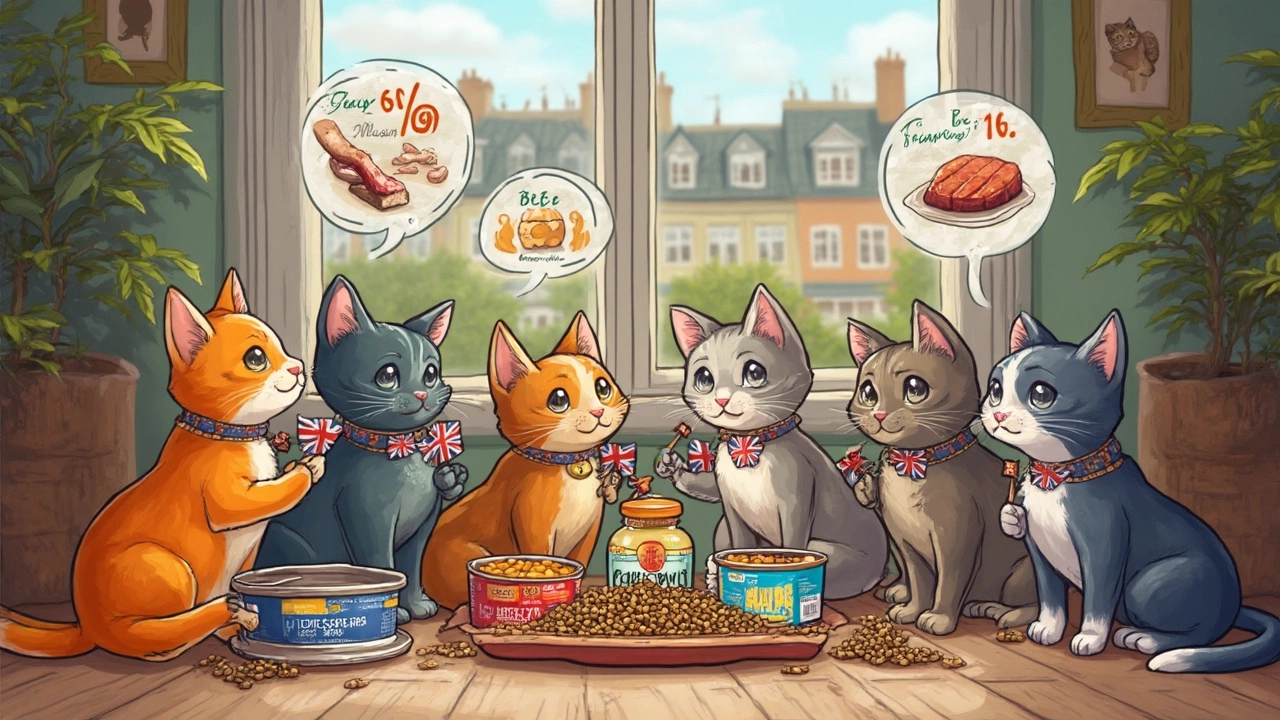Ever get lost in the cat food aisle, staring at shiny bags with words like “premium” or “grain-free,” and thinking, what actually matters for my cat? You’re not the only one. Companies love tossing in buzzwords, but what’s in the bag makes all the difference to your cat’s health.
It sounds simple, but cats are obligate carnivores, which means their bodies are built for meat first—none of that vegan nonsense. The best cat foods start with real, named protein sources, like chicken, turkey, or salmon, right at the top of the ingredients list. If you see things like ‘meat by-products’ or ‘animal digest’ leading the pack, it’s a red flag. Those are just leftovers, not choice cuts.
Protein matters most, but don’t forget about moisture. Most cats don’t drink enough water, so foods with higher moisture content (think canned or raw) can make a real difference — especially for older cats, or those who tend to get kidney troubles.
- What Makes Cat Food 'Best'?
- Reading the Label: What to Look For
- Wet vs. Dry: Which Wins?
- Practical Tips for Picking Cat Food
What Makes Cat Food 'Best'?
When people talk about the best cat food, they usually mean food that keeps cats healthy, keeps their fur shiny, and doesn’t upset their stomachs. But here’s the thing—cats aren’t all built the same. What works for your neighbor’s chunky tabby might not work for your skinny Siamese.
Cats need a high-protein diet with plenty of animal-based ingredients. Not all proteins are equal, though—chicken muscle is better than unspecified "meat" or random animal parts. Taurine, an amino acid only found in animal tissues, is a must-have in every formula. If a cat food skips this, keep walking. You’ll also want a good balance of fat. Fats give food flavor and help with a cat’s skin and coat.
Ingredients matter, but so does how digestible they are. Food that looks fancy but gives your cat diarrhea is no good. Some cats have grain allergies, but most don’t—so “grain-free” isn’t always better. A few carbs for energy are fine, so long as meat is the top ingredient.
- Look for clear protein sources at the top of the list: chicken, turkey, salmon, duck, or beef.
- Avoid foods that use meat by-products as their main protein.
- Check for taurine as an added ingredient – it's non-negotiable for cats.
- If your cat has health issues—like kidney disease—talk to your vet about special diets.
- Moisture counts! Wet food helps prevent urinary problems and dehydration.
What’s best for your cat might change as they age or deal with medical stuff. Kittens need more calories and fat. Senior cats might do better with something easier to digest. Bottom line: Always watch how your cat looks, feels, and acts after switching foods. That’s the real test—not the label.
Reading the Label: What to Look For
If you’ve ever squinted at a cat food label, you know how confusing it gets. The most important thing to spot? The first few ingredients. These should be real, named meats like chicken, turkey, or salmon, not mysterious sandwiches of “meat by-product” or “animal meal.”
Companies sometimes try to dress up cheap fillers (corn gluten, soy, or wheat) with flashy claims about 'natural' flavors. Skip those. Cats need protein, not plant-based carbs. Experts generally recommend cat foods with around 30–40% protein for dry food, and at least 8–10% protein in wet food—that’s on a dry matter basis, since moisture levels differ a lot.
- Check for specific protein (like “chicken meal” or “salmon”), not generic “meat”.
- Avoid added sugars, artificial colors, and “meat by-products”.
- Make sure taurine, an amino acid essential for cats, is on the ingredient list.
- Look for a nutrient profile that matches the AAFCO (Association of American Feed Control Officials) standards. You’ll see this statement: “Formulated to meet the nutritional levels established by the AAFCO Cat Food Nutrient Profiles.”
- Don’t let “grain-free” trick you—some brands just swap grain for starchy peas or potatoes. The focus should still be on protein.
Here’s a quick peek at what a typical high-quality dry cat food label looks like, using data from a popular premium brand:
| Nutrient | Amount |
|---|---|
| Crude Protein | 38% |
| Crude Fat | 18% |
| Crude Fiber | 3.5% |
| Moisture | 10% |
| Taurine | 0.15% |
Bottom line: the best cat food lists meat first, avoids filler junk, and hits the right benchmarks for protein, fat, and taurine. Read the label like you read food for yourself. If it sounds like something you wouldn’t eat, your cat probably won’t thrive on it either.

Wet vs. Dry: Which Wins?
The wet vs. dry cat food debate never ends. If you ask 10 cat owners, you’ll get 12 different opinions. But there are some solid facts you can rely on to make the best pick for your cat—and your routine.
Wet food, also called canned food, has a lot of water—usually about 75-80% moisture. That’s a game-changer for cats who don’t drink much from their bowls. According to the Cornell Feline Health Center,
"Canned food helps increase a cat's water intake, which can help prevent common urinary tract problems."On the downside, wet food is pricier per serving, tends to spoil faster if your cat doesn’t finish it, and can be a bit messier.
Dry food (kibble) is more convenient. You can leave it out all day without worry, and it usually costs less. Some cats love the crunch, but here’s the catch: dry food typically only has about 10% moisture. Over time, cats who live on dry food alone may not get enough water, which can lead to kidney or urinary tract issues—especially with older cats or those who’ve had bladder troubles.
Let’s break it down with some numbers:
| Type | Average Moisture | Convenience | Cost |
|---|---|---|---|
| Wet Food | 75-80% | Needs refrigeration after opening; should be eaten fresh | $$ |
| Dry Food | 8-12% | Can be left out all day; super easy for busy schedules | $ |
Some pet parents mix both, giving canned in the morning and kibble in the evening to balance hydration and convenience. If you go the dry food route, always make sure your cat has access to fresh water at all times. And don’t trust that cats will drink just because water is available—lots of felines are lazy drinkers.
The bottom line: for best cat food choices, the most important thing is your cat’s health and hydration, not what’s most convenient for you. If your cat is a big fan of dry food, try topping it with a bit of wet food or even a splash of water. If you’re not sure what works best for your kitty, your vet can help tailor a diet plan based on age, health, and even personality quirks.
Practical Tips for Picking Cat Food
Standing in front of shelves and shelves of options can make anyone second-guess. But there are a few move-right-now tips you can count on every time you’re picking food for your cat.
- Check the protein source first. Look for real, named meats like “chicken,” “beef,” or “salmon” at the top of the list. Skip anything vague or labeled as by-products or “meal” if it doesn’t name the animal source.
- Keep an eye out for carbs. Cats don’t need wheat, corn, or soy fillers. These are in some foods mostly to bulk things up for cheaper costs, not because they help your cat. If grains are high up in the list, that food isn’t the best pick.
- Look for the AAFCO statement. This label means the food meets the best cat food standards in the U.S. and covers basic nutritional needs for cats at different life stages.
- Consider your cat’s age and health. Kittens need more calories and nutrients. Senior cats or those with kidney issues often do better with more moisture and gentle proteins. Your vet can spell out what those needs look like in real-life food options.
- Ignore the marketing hype. Words like “gourmet” or “natural” sound nice but usually don’t mean anything real by law. The ingredient list and nutrition facts matter way more than the front of the bag.
- Try a few small portions before buying a huge bag. Cats can be picky, and digestive upsets are real when changing food brands. Some pet stores give sample bags or have a money-back policy if your cat does not take to a new food.
- Always have fresh water out, even if you’re feeding a moist or canned food. Hydration supports kidney and urinary health, which can save you big vet bills down the road.
Don’t just take a brand’s word for it – spot check reviews from people who have cats like yours or ask your vet for honest favorites. At the end of the day, your cat’s energy, coat, and litter box habits tell you if you’re on the right track.

